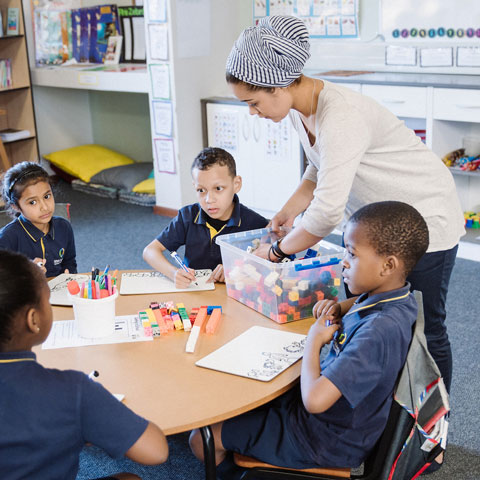Nova Pioneer Schools for Innovators and Leaders are inspired by the principles of the Reggio Emilia approach. The principles of relationships, spaces and environment are reflected in Tammy Gertzen’s classroom at our Boksburg campus.
At the heart of the Reggio Emilia approach is relationships. The school environment and spaces have been designed so that they foster interaction and communication, exploration and participation, a sense of autonomy and curiosity. In fact, the environment is thought of as the “third teacher” for its ability to foster connections between ideas, people and things.
Think about the places you spend the majority of your time – your home, your immediate neighbourhood, and the place you work. We aren’t always aware of it, but the spaces, activities and environment around us can have a big impact on how we feel, and what feels possible or allowable in that space.
Being aware of how space, and place, shapes how we feel about ourselves and each other. In the 1970s Reggio Emilia began working on a project that looked specifically at the relationship between their philosophy of education, the architecture and resources of their schools, and their health and safety regulations. Through this project, they developed a set of design principles aimed at helping each school cultivate its own identity while still fostering values that are consistent across all the schools.
What does this look like in practice?
Care and beauty
The values of the Reggio Emilia approach and the unique identity of each school are communicated throughout classrooms and spaces. Over the decades, the schools have even worked with local companies to design particular kinds of furniture that can enhance children’s experiences and thinking. The environment, the spaces, the objects and furniture in them are all beautifully made and arranged. This beauty isn’t seen as a ‘nice to have’. It’s central to the educational experience. Beautiful spaces communicate that you care about the people and relationships they make in them, and encourage these people (big and small) to take care of each other and the things in that space. As the Charter of Services suggests, “taking care of the indoor and outdoor environment, the furniture, objects and materials by children and adults is an educational act that creates well-being, a sense of familiarity and belonging, aesthetic taste and the pleasure of inhabiting spaces, which are also primary prerequisites and conditions for safety”.
Environment as third teacher
Children are acutely sensitive to the world around them, and how a space or a particular material suggests certain possibilities. In Reggio Emilia, teachers welcome this influence and actively cultivate it, by recognising the environment as the third teacher in the classroom, capable of stimulating, deepening and challenging children’s thinking without saying a word. In a similar vein, they pay great attention to the intelligence of materials – the power of the natural and manufactured world to suggest certain uses or functions. When deciding what materials to introduce in the school around a particular investigation, teachers will first spend time exploring its particular ‘intelligence’, what possibilities it suggests to you as you explore it with all your senses.
Sustainability and recycled materials
Both natural objects (like wood, stones and plants) and recycled materials (like plastic trays, pipes, material offcuts) are used to stimulate and deepen learning in the school. Schools aim to encourage empathy, the sustainable use of materials, and a kind resourcefulness that comes of being able to see new possibilities in natural and recycled objects and put them to use. When exploring a topic to do with the natural world, children are encouraged to go out into the environment, to see their object of study in its natural context (not to remove it), to get in relationship with the nature.
As for recycled materials, the city of Reggio Emilia has evolved recycling centres known as Remida, where offcuts and waste materials produced by the city’s factories and local artisans are collected, cleaned, and artfully displayed. These Remida are a free resource for teachers, a place they can go to explore the possibilities inherent in different materials, and collect what they need for their classroom or current investigation. “Remida is named after King Midas with the golden touch… It’s a name to acknowledge that everything, any material, can be, in our hands, in the children’s hands, like gold. A treasure. There is beauty in the imperfect.”
The set up of provocations in the classroom inspires curiosity and imagination, it fosters communication and collaboration and supports enquiry and investigation. All the elements of great learning.
Applications to our Boksburg campus are open, contact admissions.boksburg@novapioneer or click below.



